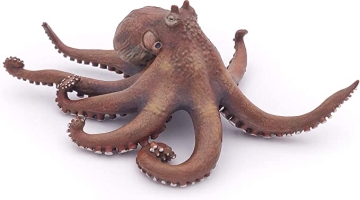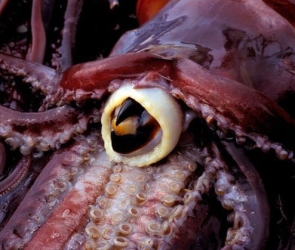  There are around 300 known species of octopus. Octopuses are eight-limbed, with soft bodies, big rounded heads, bulging eyes, and tentacles.
Octopuses are a type of mollusc called a cephalopod, along with squids and cuttlefish.
There are around 300 known species of octopus. Octopuses are eight-limbed, with soft bodies, big rounded heads, bulging eyes, and tentacles.
Octopuses are a type of mollusc called a cephalopod, along with squids and cuttlefish. The octopus has a hooked, parrot-like beak on its underside, in the middle of its arms. Octopus beaks are made from a hard substance called chitin, which is the same stuff lobster and crab shells are made of.  An octopus preys on things like crabs and clams, which have hard outer shells. The octopus will use a special tongue called a radula to drill a hole into the hard shells and access their flesh.
They use their beak like a pair of scissors, cutting apart softer food into bite-sized chunks.
An octopus preys on things like crabs and clams, which have hard outer shells. The octopus will use a special tongue called a radula to drill a hole into the hard shells and access their flesh.
They use their beak like a pair of scissors, cutting apart softer food into bite-sized chunks.Octopuses are venomous, though most are not lethal to humans. Many do not have any effect on most land animals. Their venom is used to subdue other sea creatures, like lobsters and crabs. The venom is contained within specialized salivary glands, similar to human saliva glands. Most of their venom is stored in the salivary glands behind the octopus's beak and is released through biting. Octopus venom contains neurotoxins, and once injected into its prey, these toxins cause muscle relaxation and paralysis. Octopuses also use venom for self-defense, but only as a last resort. In fact, even the most venomous octopuses are passive and gentle creatures and will try to swim away if they feel threatened.  The suction cups on an octopus' arms are called suckers.
The soft, squishy part of the sucker that is most visible is the infundibulum. This is surrounded on the edge by a rim of mucous-like epithelium. In the center of the infundibulum is a roundish cavity known as the acetabulum.
The suction cups on an octopus' arms are called suckers.
The soft, squishy part of the sucker that is most visible is the infundibulum. This is surrounded on the edge by a rim of mucous-like epithelium. In the center of the infundibulum is a roundish cavity known as the acetabulum.Each sucker is attached to the arm by a muscular base that can rotate the sucker in any direction and can elongate it to twice its normal length. This gives the animals such touch sensitivity that they can 'walk' an item along an arm simply by moving the suckers. Suckers are able to maintain a powerful grip because of their suction cup-like shape. The muscle fibers which extend radially from the center to the rim of each sucker also contribute to strength. Octopuses are the world's smartest invertebrates. Octopuses use tools, such as coconut shells for shelter and jellyfish tentacles for defense. They can recognize individuals outside of their own species, including humans. They work with other species, like groupers, to hunt. They excel at puzzles, such as unscrewing lids to jars and fitting L-shaped objects through small square openings. Octopuses can retain information for several months. They're emotional creatures, capable of feeling affection and excitement.  Their flexible, highly specialised limbs enable octopuses to carry out some unique tasks. In fact, octopuses are one of the few animals, aside from humans, that can use tools to their advantage. Other examples include dolphins, crows and chimpanzees. They’re known to build dens on the sea floor out of coconut shells, empty gastropod shells and other materials and stay in them for several days.
Their flexible, highly specialised limbs enable octopuses to carry out some unique tasks. In fact, octopuses are one of the few animals, aside from humans, that can use tools to their advantage. Other examples include dolphins, crows and chimpanzees. They’re known to build dens on the sea floor out of coconut shells, empty gastropod shells and other materials and stay in them for several days.
Octopuses have three hearts. Two of these hearts pump blood to the gills, where it picks up oxygen and becomes oxygenated. The oxygenated blood is then sent to deliver oxygen to the rest of the body by the third central heart. Octopuses use a protein known as haemocyanin which contains copper, to move oxygen around the body. When this haemocyanin is carrying oxygen, it turns a blue colour, which is why octopus blood is blue. In contrast, humans use a protein that contains iron (haemoglobin) to transport oxygen around the body, which gives human blood its red colour. Haemocyanin isn’t as good at carrying oxygen as haemoglobin, so octopuses need extra hearts to make sure enough oxygen is delivered to the body. The octopus is preyed upon by dolphins, sharks, large fish and even seabirds. They’ve evolved some strategies for escaping predators. The first is octopus ink, which helps octopuses to disappear under a veil of smoke. A second is the 'quick-reverse'; if all else fails, octopuses can rapidly pump water through a tube in their body, known as a siphon. This propels them backwards through the water at speeds of up to 40kmh. There are eleven species of octopus. Here are few: 
In case you were wondering, 'octopuses' is the correct plural form of 'octopus'. While 'octopi' has become popular in modern usage, it’s wrong. 'Octopi' comes from the belief that Latin origins should have Latin endings. However, octopus is not a Latin word, but a Latinized form of the Greek word 'októpus'. Generally, when a noun enters into English, it is pluralized as an English word rather than in its original form. 'Octopuses' may sound peculiar to some, but this is the preferred plural. Trust me; my daughter Emily is a high school English teacher! |